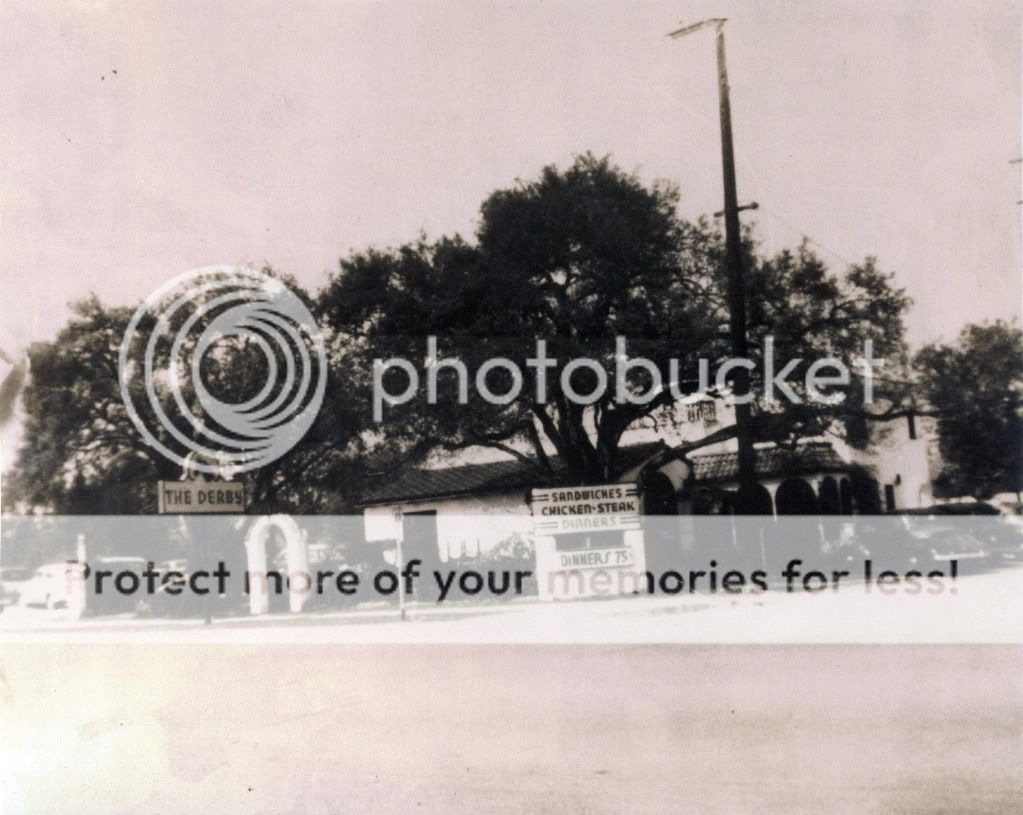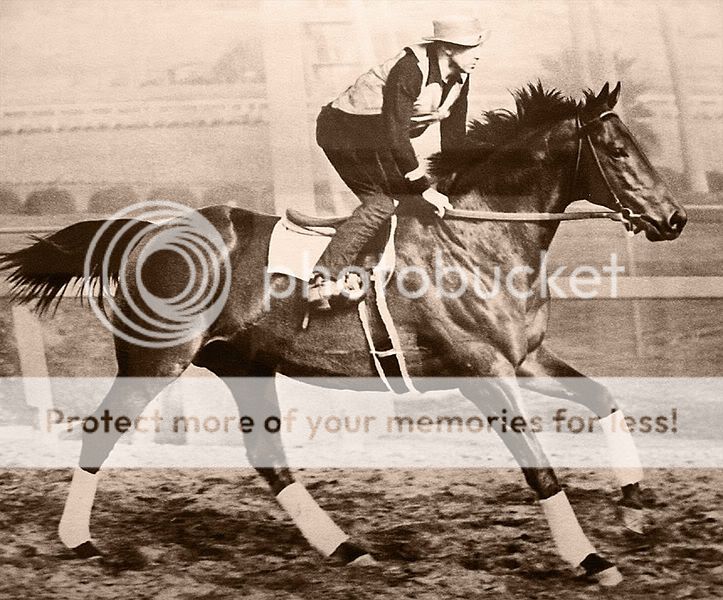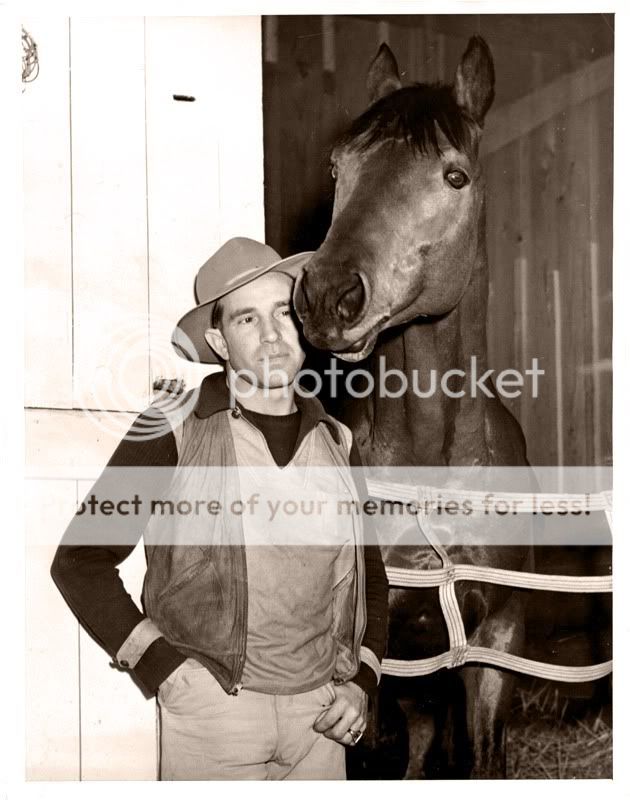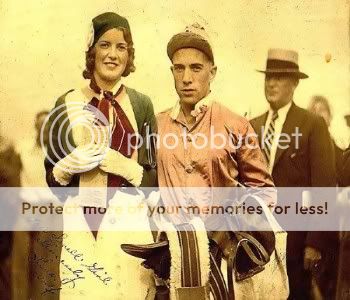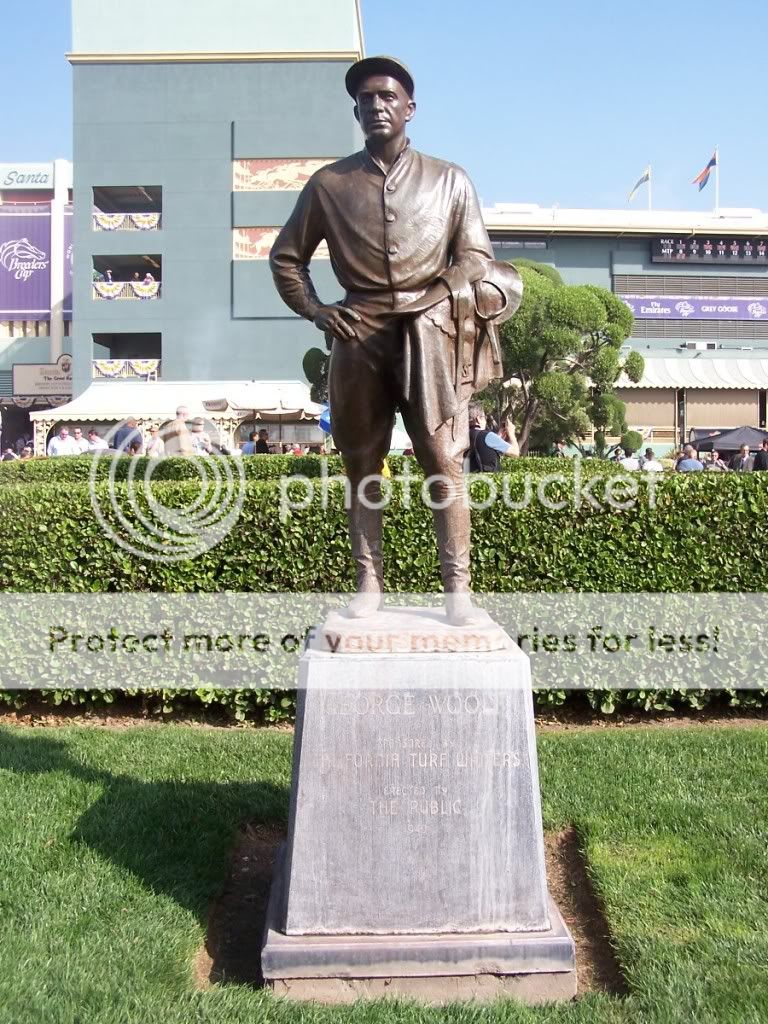Not a direct line ancestor but nevertheless a relative: his great grandfather was none other than our direct line ancestor, John Woolf, friend of Joseph Smith. His wife was: Genevieve Caroline Braun
Click here for The Iceman of the Saddle a detailed view of George's live from Champions by Setback Athletes Who Overcame Physical Handicaps by DAVID K.BOYNICK
Click: The Death of George Woolf, 1946
For information on his wife: Genevieve
Race Horse Jockey. Nicknamed "Iceman" because of his steady nerves and flawless sense of timing, he was born on a ranch in Alberta, Canada. He received his start competing in races at bush tracks and across the border at Montana fairs while a teenager. He suffered from diabetes and had to regulate his diet and exercise which limited his number of mounts. He rode some of the finest horses of his era but considered Seabiscuit the best of all. In the 1938 Hollywood Gold Cup, he brought Seabiscuit from 14 lengths back to win the race. He was the nation's leading stakes-winning jockey from 1942 to 1944. Tragedy struck in the late afternoon during the fourth race at Santa Anita Park on January 3, 1946. George Woolf, aboard "Please Me," was rounding the club house turn when fans saw him slip from the saddle probably unconscious, a symptom of dieting and diabetes, pitching the famed jockey head first into the ground before a stunned crowd. He was taken to St. Luke's Hospital in Pasadena with a brain concussion, and died the next morning. He was enshrined in the Thoroughbred Racing Hall Of Fame in 1955 and the Canadian Horse Racing Hall of Fame in 1976. His greatest honor was the establishment in 1985 of the "George Woolf Jockey Award" which by a jockey vote nationwide determines the best rider of the year and is racing's most prestigious accolade. His death led to the introduction of the Caliente Safety Helmet that is now mandatory riding equipment. In a church service attended by 1,500 people, Gene Autry added to the sadness with his singing of the western song "Empty Saddles in the Old Corral." (bio by: Donald Greyfield (inactive))
The Iceman's Watering Hole
George Woolf's Derby, near Santa Anita, was the great jockey's personal haunt. It may still be
The Iceman Cometh, or at least his ghost does, on nights when The Derby restaurant in Arcadia, Calif., is filled with patrons rehashing the day's card at nearby Santa Anita Park. Some believe The Derby is haunted by the spirit of George Woolf, a jockey known as the Iceman for the way he sat chillily on a horse until the very last moments of a race.
Woolf bought the little restaurant on Huntington Drive in 1938, renamed it in honor of the Kentucky Derby and festooned its walls with racing memorabilia, much of it pertaining to the first Saturday in May at Churchill Downs. The Derby has been popular with Santa Anita regulars for almost 60 years; it will be packed nightly in the weeks before the 10th annual Breeders' Cup, which will be held at the racetrack on Saturday, Nov. 6.
The restaurant's current owner, Chip Sturniolo, 42, is among those who are convinced his establishment is haunted. "I swear George Woolf's ghost lives here," he says. " Woolf lived above the restaurant, you know. Sometimes, looking through old scrapbooks or walking around, you can almost feel him there with you."
Perhaps the ghost likes to admire the Calumet Farm silks the 36-year-old Woolf was wearing on Jan. 3, 1946, the day he suffered fatal injuries when Please Me threw him at Santa Anita. Possibly he inspects the saddle Woolf was given in 1932 by Billie Elliot, the jockey of Phar Lap, the great New Zealand champion whose career—and mysterious death—was the subject of a 1983 movie. Or maybe he looks wistfully at the photos of Kentucky Derby winners. Could the gentle breeze that works its way through the restaurant be a ghostly sigh over the fact that Woolf never won the Derby in nine tries from 1932 to 1945?
To this day Santa Anita honors Woolf's memory by presenting an annual award in his name to a jockey who exemplifies the talent, honesty and sportsmanship that made the Iceman among the most respected riders of his day.
So selective that he would seldom accept more than 200 mounts a year, Woolf rode such champions as Seabiscuit, Whirlaway, Kayak II, Pavot, By Jimminy and Challedon. He twice led the nation in stakes victories, in 1942 (23) and '44 (14). His triumphs included the 1936 Preakness (Bold Venture), the 1938 Hollywood Gold Cup (Seabiscuit) and the 1942 Jockey Club Gold Cup (Whirlaway).
His best Kentucky Derby finishes, though, were a couple of seconds—on Staretor, who finished eight lengths behind Whirlaway in 1941, and Broadcloth, runner-up by 4 lengths to Pensive in 1944. As time passed and Woolf continued to come up short in the Derby, he told friends, "I guess I jinxed myself when I named my place The Derby. Maybe I'll have to settle for a Derby in Arcadia instead of one in Louisville." Indeed, he won the 1945 Santa Anita Derby—a major Kentucky Derby prep—aboard Bymeabond but got off that colt to ride Sea Swallow in Louisville. Alas, Sea Swallow finished seventh, just behind Bymeabond and 18 lengths behind the victorious Hoop, Jr.
In 1952, Sturniolo's parents, known around Santa Anita as Slugger and Murph, bought The Derby from Woolf's widow, Genevieve, who also let them have the scrapbooks she had kept of her late husband's exploits. In addition she gave them such treasures as the silks Woolf was wearing when he was killed, some of the whips he used in his greatest races, and Phar Lap's saddle. All these are on display in the restaurant's trophy cases, along with such items as the whip the great jockey Earl Sande used in four Kentucky Derby rides in the '20s, a huge panoramic photo of Derby Day in '38, Woolf's bronzed golf shoes and photos of every Derby winner since Aristides in 1875.
On certain nights, when the restaurant is overcrowded, Sturniolo will allow special racetrack guests to dine in the upstairs rooms where Woolf once lived. Many of those diners probably know little about the Iceman. But they might be intrigued to learn that both times Woolf finished second in the Derby, the race he wanted most to win, he was beaten by a horse from Calumet, the farm whose silks he was wearing during the fatal accident.
Anybody feel a chill?
Woolf bought the little restaurant on Huntington Drive in 1938, renamed it in honor of the Kentucky Derby and festooned its walls with racing memorabilia, much of it pertaining to the first Saturday in May at Churchill Downs. The Derby has been popular with Santa Anita regulars for almost 60 years; it will be packed nightly in the weeks before the 10th annual Breeders' Cup, which will be held at the racetrack on Saturday, Nov. 6.
The restaurant's current owner, Chip Sturniolo, 42, is among those who are convinced his establishment is haunted. "I swear George Woolf's ghost lives here," he says. " Woolf lived above the restaurant, you know. Sometimes, looking through old scrapbooks or walking around, you can almost feel him there with you."
Perhaps the ghost likes to admire the Calumet Farm silks the 36-year-old Woolf was wearing on Jan. 3, 1946, the day he suffered fatal injuries when Please Me threw him at Santa Anita. Possibly he inspects the saddle Woolf was given in 1932 by Billie Elliot, the jockey of Phar Lap, the great New Zealand champion whose career—and mysterious death—was the subject of a 1983 movie. Or maybe he looks wistfully at the photos of Kentucky Derby winners. Could the gentle breeze that works its way through the restaurant be a ghostly sigh over the fact that Woolf never won the Derby in nine tries from 1932 to 1945?
To this day Santa Anita honors Woolf's memory by presenting an annual award in his name to a jockey who exemplifies the talent, honesty and sportsmanship that made the Iceman among the most respected riders of his day.
So selective that he would seldom accept more than 200 mounts a year, Woolf rode such champions as Seabiscuit, Whirlaway, Kayak II, Pavot, By Jimminy and Challedon. He twice led the nation in stakes victories, in 1942 (23) and '44 (14). His triumphs included the 1936 Preakness (Bold Venture), the 1938 Hollywood Gold Cup (Seabiscuit) and the 1942 Jockey Club Gold Cup (Whirlaway).
His best Kentucky Derby finishes, though, were a couple of seconds—on Staretor, who finished eight lengths behind Whirlaway in 1941, and Broadcloth, runner-up by 4 lengths to Pensive in 1944. As time passed and Woolf continued to come up short in the Derby, he told friends, "I guess I jinxed myself when I named my place The Derby. Maybe I'll have to settle for a Derby in Arcadia instead of one in Louisville." Indeed, he won the 1945 Santa Anita Derby—a major Kentucky Derby prep—aboard Bymeabond but got off that colt to ride Sea Swallow in Louisville. Alas, Sea Swallow finished seventh, just behind Bymeabond and 18 lengths behind the victorious Hoop, Jr.
In 1952, Sturniolo's parents, known around Santa Anita as Slugger and Murph, bought The Derby from Woolf's widow, Genevieve, who also let them have the scrapbooks she had kept of her late husband's exploits. In addition she gave them such treasures as the silks Woolf was wearing when he was killed, some of the whips he used in his greatest races, and Phar Lap's saddle. All these are on display in the restaurant's trophy cases, along with such items as the whip the great jockey Earl Sande used in four Kentucky Derby rides in the '20s, a huge panoramic photo of Derby Day in '38, Woolf's bronzed golf shoes and photos of every Derby winner since Aristides in 1875.
On certain nights, when the restaurant is overcrowded, Sturniolo will allow special racetrack guests to dine in the upstairs rooms where Woolf once lived. Many of those diners probably know little about the Iceman. But they might be intrigued to learn that both times Woolf finished second in the Derby, the race he wanted most to win, he was beaten by a horse from Calumet, the farm whose silks he was wearing during the fatal accident.
Anybody feel a chill?
Current pictures of the Derby:
George Monroe Woolf (May 31, 1910 – January 4, 1946) was a Canadian-born thoroughbred race horse jockey and the namesake of the annual jockey's award given by the United States Jockeys' Guild.
Born on a ranch in Cardston, Alberta, his mother had been a trick rider in a circus and his father rode in rodeos. As such, Woolf was taught to ride horses as a child and as a teenager he rode in horse races and competed in rodeo events in Alberta and Montana. He began racing thoroughbreds professionally in 1928 in Vancouver, British Columbia before going to Tijuana, Mexico and then to Arcadia, California where he would make his permanent home.
Using Santa Anita Park as his home base, George Woolf became one of the premier jockeys of his era known by fellow jockeys and fans as "The Iceman." He earned the nickname not just because of his renowned patience in waiting for the right time to have his horse make a move, but also because of his totally calm attitude even before major races when he would often take a nap while other jockeys nervously paced about.
While he was establishing himself as one of America's leading jockeys, he was diagnosed with what is now known as type 1 diabetes. Only a few years earlier, before the discovery of insulin, such a diagnosis would have been a death sentence. Because of his condition, and the nature of diabetes management in the 1930s and 1940s, Woolf had to regulate his weight so as never to be in a position where he would be forced into rapid dieting.
His racing success allowed him to accept only a few mounts each week and for years that kept him in the best possible physical condition. Despite his limited number of races and the fact that he had a relatively short career, George Woolf won ninety-seven major stakes races around the United States including the Hollywood Gold Cup Stakes, the American Derby and the Belmont Futurity Stakes three years running. He made history in 1935 when he rode Azucar to victory in the first $100,000 horse race, the Santa Anita Handicap, defeating such greats as Equipoise and Twenty Grand. Woolf finished second twice at the Kentucky Derby and won the 1936 Preakness Stakes. He is also remembered for his tactical performance in the famous 1938 match race when he rode Seabiscuit to victory over the heavily favored U.S. Triple Crown champion War Admiral in the Pimlico Special.
His racing success allowed him to accept only a few mounts each week and for years that kept him in the best possible physical condition. Despite his limited number of races and the fact that he had a relatively short career, George Woolf won ninety-seven major stakes races around the United States including the Hollywood Gold Cup Stakes, the American Derby and the Belmont Futurity Stakes three years running. He made history in 1935 when he rode Azucar to victory in the first $100,000 horse race, the Santa Anita Handicap, defeating such greats as Equipoise and Twenty Grand. Woolf finished second twice at the Kentucky Derby and won the 1936 Preakness Stakes. He is also remembered for his tactical performance in the famous 1938 match race when he rode Seabiscuit to victory over the heavily favored U.S. Triple Crown champion War Admiral in the Pimlico Special.
During the running of the fourth race at Santa Anita Park on January 3, 1946, George Woolf fell from his horse as he rounded the clubhouse turn. Suffering from a concussion, he was taken to hospital where he died the following day. Both the jockeys in the race and the track stewards reported that they had not witnessed any incident that would have caused such a fall and it is generally believed his diabetic condition may have resulted in him suffering a dizzy spell or fainting.
The shocking death at the age 35 of one of the country's best and most respected jockeys, and a favorite of fans, led to the creation of the George Woolf Memorial Jockey Award. During his career (1928-1946) Woolf had 3,784 mounts, 721 wins (19.1%), 589 seconds and 468 thirds. Following its creation, George Woolf was an inaugural inductee into the National Museum of Racing and Hall of Fame in 1955 and Canada's Sports Hall of Fame in 1956. He was voted into the Canadian Horse Racing Hall of Fame in 1976.
When asked which was the best racehorse he'd ever ridden, Woolf answered immediately, "Seabiscuit."
A bronze statue of George Woolf was erected in his honor in the European-style paddock at Santa Anita Park. He is interred in the Forest Lawn Memorial Park Cemetery in Glendale, California.
In the 2003 film, Seabiscuit, Woolf was portrayed by Hall of Fame jockey Gary Stevens. Stevens had won the George Woolf Memorial Jockey Award in 1996.
From another source:
Race Horse Jockey. Nicknamed "Iceman" because of his steady nerves and flawless sense of timing, he was born on a ranch in Alberta, Canada. He received his start competing in races at bush tracks and across the border at Montana fairs while a teenager. He suffered from diabetes and had to regulate his diet and exercise which limited his number of mounts. He rode some of the finest horses of his era but considered Seabiscuit the best of all. In the 1938 Hollywood Gold Cup, he brought Seabiscuit from 14 lengths back to win the race. He was the nation's leading stakes-winning jockey from 1942 to 1944. Tragedy struck in the late afternoon during the fourth race at Santa Anita Park on January 3, 1946. George Woolf, aboard "Please Me," was rounding the club house turn when fans saw him slip from the saddle probably unconscious, a symptom of dieting and diabetes, pitching the famed jockey head first into the ground before a stunned crowd. He was taken to St. Luke's Hospital in Pasadena with a brain concussion, and died the next morning.
He was enshrined in the Thoroughbred Racing Hall Of Fame in 1955 and the Canadian Horse Racing Hall of Fame in 1976. His greatest honor was the establishment in 1985 of the "George Woolf Jockey Award" which by a jockey vote nationwide determines the best rider of the year and is racing's most prestigious accolade. His death led to the introduction of the Caliente Safety Helmet that is now mandatory riding equipment. In a church service attended by 1,500 people, Gene Autry added to the sadness with his singing of the western song "Empty Saddles in the Old Corral." (bio by: Donald Greyfield)
He was enshrined in the Thoroughbred Racing Hall Of Fame in 1955 and the Canadian Horse Racing Hall of Fame in 1976. His greatest honor was the establishment in 1985 of the "George Woolf Jockey Award" which by a jockey vote nationwide determines the best rider of the year and is racing's most prestigious accolade. His death led to the introduction of the Caliente Safety Helmet that is now mandatory riding equipment. In a church service attended by 1,500 people, Gene Autry added to the sadness with his singing of the western song "Empty Saddles in the Old Corral." (bio by: Donald Greyfield)
October 18, 1993 (Sports Illustrated article)
With his favorite ride: Seabiscuit:
May 11, 1938:
George Woolf on Pompoon
Original caption:Pompoon Wins the Dixie Handicap. Baltimore, Maryland: Pompoon, J.H. Louchheim's "almost" horse, clipped three fifths of a second from Seabiscuit's track record for the mile and three-sixteenths in winning the $20,000 added Dixie Handicap from Busy K and Masked General, in that order. Under a superb ride of jockey George Woolfe, the four year old Pompey colt covered the distance in 1.56 4/5.
August 12, 1938:
Seabiscuit and Ligaroti Racing at Del Mar
Original caption:Del Mar, California. Racing Seabiscuit won by a nose over Ligaroti in their $25,000 winner-take-all match race here, August 12th. Georgie Woolf was riding the winner. Time for the mile and a eigth was 1:49. Photo shows: Seabiscuit (nearest camera) with jockey Georgie Woolf up, winning from Ligaroti, with Spec Richardson up, at the del Mar race track.
August 13, 1938
Seabiscuit and Ligaroti at Del Mar
Original caption:Before the $25,000 Handicap Match Race. Del Mar, California: Seabiscuit, (A), and Ligaroti, (B), from South America "parade to the post to compete in their two-horse special match race for $25,000. George Woolf is up on C.S. Howard's Seabiscuit, while Speck Richardson is up on the invader. Seabiscuit won the race.
November 1, 1938:
Seabiscuit Winning War Admiral Match Race
Original caption:As Seabiscuit, War Admiral Fought for Lead. Baltimore, Maryland: Seabiscuit is on the inside, fighting it out almost neck and neck with War Admiral for the lead in their historic match race at Pimlico. The horses were just breaking into the home stretch as this photo was made. Seabiscuit was next to the rail and picked up a head on the turn, then stretched out and finished far in front.
Seabiscuit and War Admiral Racing to Finish
In the greatest match race in history, Seabiscuit, on the inside and ridden by George Woolf, tears away from War Admiral, ridden by Charlie Kurtsinger. Seabiscuit finished four lengths ahead of the Admiral in the record breaking time of 1:56 3/5 for the mile and 3/16.
Howard and Smith Winning Horse Seabiscuit
Original caption:The "Winnah! and New Champeen". Pimlico Track, Maryland. Owner C.S. Howard, left, trainer, T. Smith, right, and the great "Seabiscuit" are pictured at Pimlico Track just after the Biscuit beat "War Admiral" in match race for the turf "Championship". Jockey G. Woolf rode owner Howard's great little Biscuit to his thrilling four-lengths victory over the highly touted "War Admiral". Fifty-five thousand fans jammed Pimlico's stands to see the long awaited meeting of these turf giants. Veteran Trainer Suspended on Dope Charge. New York-Tom Smith, veteran trainer for the Main Chance Farms Stable whose license was revoked today by the stewards of the jockey club on a charge that he doped a horse. It was also ordered that Smith, who trained Seabiscuit and Kayak II, be denied the privileges of all tracks. The penalty is effective for one year, ending November 1, 1946.
Hollywood Park Official Program
July 16th, 1938
Inaugural running of the Hollywood Gold Cup
won by Seabiscuit - Specify 2nd - Whichcee 3rd
July 16th, 1938
Inaugural running of the Hollywood Gold Cup
won by Seabiscuit - Specify 2nd - Whichcee 3rd
1939:
Racehorse Seabiscuit Finishing Second
Original caption:Seabiscuit, Lame, Loses Race. Arcadia, Calif. In what may turn out to be its last race, as the result of lameness, Seabiscuit is shown here Feb. 14 finishing second today on the Santa Anita Track. Today, owned by Neil McCarthy and ridden by Nick Wall, won by 2 1/2 lengths. Seabiscuit, owned by C.S. Howard, was ridden by Georgie Woolf.
July 16, 1942:
Rounders Chasing Whirlaway Down Track
Original caption:Churning up the Suffolk Downs track with his famed crusher kick, Whirlaway, ridden by jockey Woolf, roars toward the finish line ahead of Rounders to win the Massachusetts Handicap in record-breaking time and bury Seabiscuit's all-time money-winning record by winning the $43,850 prize money and bringing his lifetime earnings to $454, 336.
September 13, 1942
Georgie Woolf and Whirlaway in Winners Circle
Original caption:Trainer Ben Jones holds Warren Wright's speedy Whirlaway in the winner's circle at Narragansett Park after the long-tailed colt's up-from-behind victory in yesterday's $25,000 Narragansett Special. Jockey is Georgie Woolf. The Special, expected to be the year's dream race, bringing together Whirly and Al Sabath's Alsab, turned into a nightmare when the latter was scratched.
October 3, 1942:
Georgie Woolf Riding Whirlaway into Winners Circle
Original caption:Georgie Woolf, atop Whirlaway, brought in two high-paying winners today at Belmont Race Track - Whirlaway bringing in $25,000 and Occupation netting $70,000. Ben A. Jones leads the horse after the sixth race, the Jockey Club Gold Cup Competition.
October 28, 1942:
Whirlaway Racing Out in Front
Original caption:In this unusual photo showing all four hooves off the ground, Whirlaway with jockey George (Iceman) Woolf up, crosses the finish line to win the $10,000 Pimlico Special. It was a lonesome solo gallop for Whirly, who tried to run his best when he heard the roars of the crowd, but was held in until the stretch, when he was allowed to spurt to the finish. The Special originally was slated to be a two-horse race with Alsab, the other contender, but early this week, Al Sabath decided to withdraw his star racer.
1945:
George Woolf in Dressing Room
Original caption:Shown here as he appeared a year ago in the Jockey's dressing room at Washington Park, Jockey George Woof, one of America's greatest stake racers, sponges off after a winning ride. The 36 year old Woof died today of injuries suffered in a spill at Santa Anita Track yesterday. He was top money winner in 1944.
January 6, 1946, George's last ride:
George Woolf's Riderless Horse Finishing Race
Special memorial at Santa Anita race track;
From newfamilysearch:
| Burial: Forest Lawn Memorial Park (Glendale) Glendale Los Angeles County California, USA Plot: The Great Mausoleum, Gardenia Terrace, the Sanctuary of Providence, Mausoleum Crypt 9707 | |

